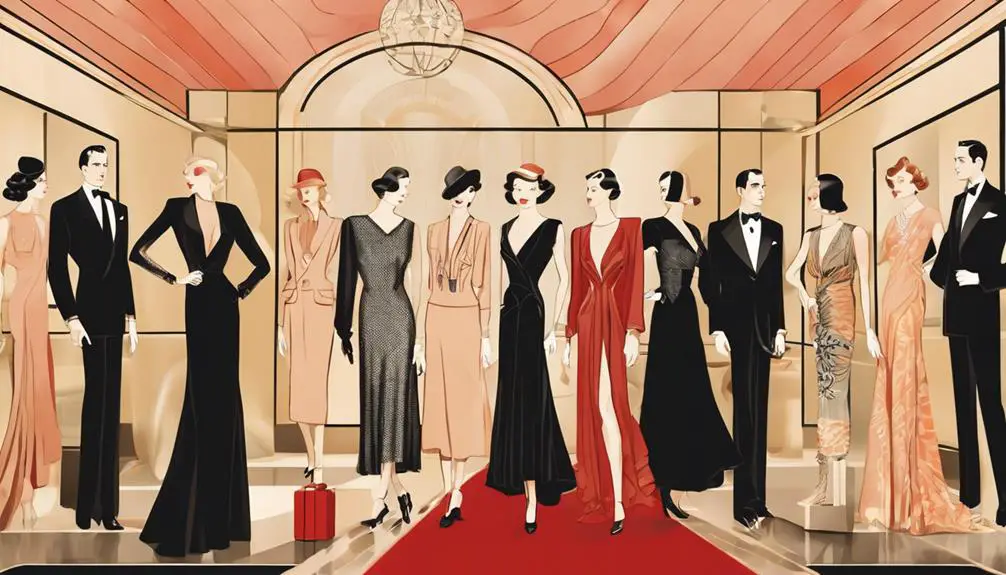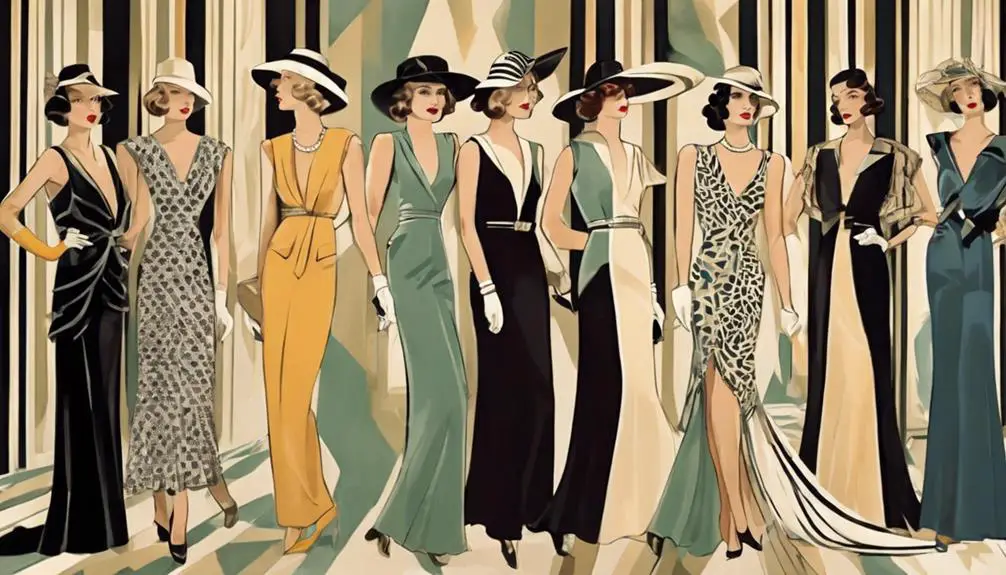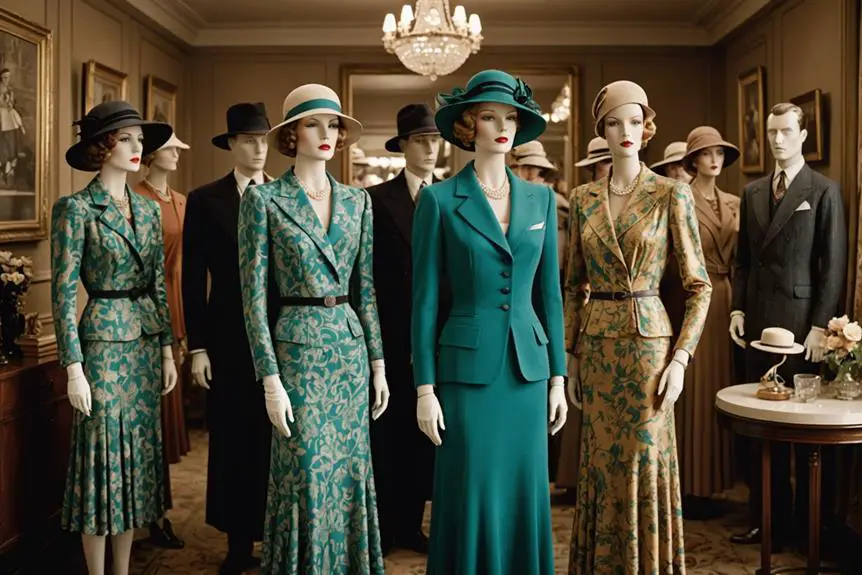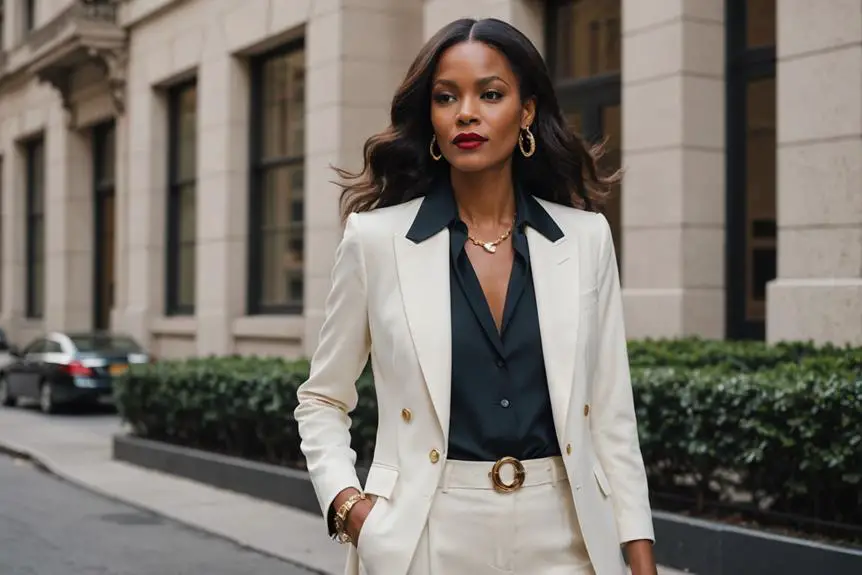In the late 1930s, fashion brands like Coco Chanel, Elsa Schiaparelli, and Norman Hartnell led the way with innovative and stylish designs. Chanel is famous for her elegant suits and the timeless Chanel No. 5 perfume, while Schiaparelli brought surrealist elements to life with bold colors and whimsical patterns, such as her lobster dress. Hartnell catered to royalty, designing luxurious gowns that combined classic tailoring with modern flair. Meanwhile, Madeleine Vionnet's bias-cut dresses emphasized a woman's natural silhouette, allowing freedom of movement. These iconic brands not only shaped fashion then, but also set trends that still resonate today, revealing more about their lasting impact.
Key Designers of the Era

In the late 1930s, fashion enthusiasts often found themselves captivated by the groundbreaking work of several key designers who reshaped the industry. Coco Chanel stood out with her iconic style, particularly the timeless Chanel suit that emphasized casual elegance. Her designs revolutionized women's fashion by combining comfort with sophistication.
Meanwhile, Elsa Schiaparelli gained fame for her avant-garde creations that incorporated surrealist elements, like her signature "shocking pink" and the unforgettable lobster dress. She pushed boundaries, inspiring others to explore artistry in fashion.
Madeleine Vionnet, known for her innovative bias-cut gowns, celebrated the female form through flowing silhouettes that flattered every figure. Her designs allowed women to move freely while looking stunning, making her a significant influence during this era.
Norman Hartnell earned renown for his opulent evening dresses, with royal commissions that showcased his mastery of luxurious fabrics and intricate embroidery. His gown for Queen Elizabeth's coronation in 1937 remains a remarkable example of his craftsmanship.
Valentina, an influential American designer, captured attention with her elegant, floor-length gowns and inventive use of color. Her creations attracted a clientele of Hollywood stars and socialites, earning her a firm place in the fashion world.
Together, these designers provided rich fashion inspiration and shaped the aesthetics of the late 1930s, leaving a lasting legacy that still resonates today.
Iconic Fashion Brands
Building on the innovative spirit of the key designers of the late 1930s, several iconic fashion brands emerged that not only defined the era but also set the stage for future trends.
Coco Chanel led the charge, revolutionizing women's fashion with her emphasis on casual elegance and the use of jersey fabric. Her designs, alongside the timeless Chanel No. 5 perfume, became symbols of sophistication.
Meanwhile, Elsa Schiaparelli introduced surrealism into the fashion world. Her bold colors and unique patterns, like her famous "shocking pink," captivated fashion icons and set new standards for creativity. The wrap dress and trompe-l'œil sweaters she created were unlike anything seen before.
Madeleine Vionnet played an essential role in shaping evening gowns during this time. Her bias-cut designs celebrated the female form, offering fluidity and movement that became hallmarks of late 1930s elegance.
In contrast, Norman Hartnell gained fame as the royal couturier to Queen Elizabeth, crafting luxury designs that blended traditional tailoring with modern flair.
Valentina, known for her graceful, floor-length dresses, catered to a high-profile New York clientele. Her emphasis on simplicity and elegance made her a favorite among the elite.
Together, these designers not only defined the fashion landscape of their time but also left lasting legacies that continue to influence the industry today. Their innovative approaches and unique perspectives transformed fashion into an art form, showcasing how style can express individuality and creativity.
Influential Fashion Trends

Emerging from the innovative designs of the late 1930s, several influential fashion trends reshaped women's wardrobes and set new standards for style. One standout was the bias-cut dress, popularized by the brilliant designer Madeleine Vionnet. This dress style accentuated natural curves, allowing for fluid movement without the constraints of restrictive undergarments. Vintage clothing enthusiasts often seek out these timeless pieces, as they reflect the quality and craftsmanship of that era, a characteristic that can be compared to identifying vintage Ralph Lauren.
The fashion scene also saw Elsa Schiaparelli making waves with her surrealistic designs and vibrant colors, like her iconic "shocking pink," which became a signature hue of the era. Hollywood played a vital role in shaping these trends, with stars like Greta Garbo and Marlene Dietrich leading the charge in glamorous eveningwear that captured the public's imagination.
As women began entering the workforce in greater numbers, tailored suits gained popularity. These outfits featured fitted jackets and pencil skirts, emphasizing a chic, professional aesthetic that reflected women's evolving roles in society.
The introduction of synthetic fabrics like rayon and nylon further revolutionized women's fashion, making stylish clothing more accessible and affordable for many.
This era, marked by bold choices and innovative designs, laid the foundation for modern women's fashion. From the elegant lines of the bias-cut dress to the sleek silhouettes of tailored suits, these influential trends not only defined the late 1930s but also inspired generations to come.
Fabric Innovations
The late 1930s not only transformed fashion aesthetics but also marked a notable turning point in fabric innovations. This period saw the introduction of synthetic fibers like rayon and nylon, which revolutionized fabric availability and affordability. With these materials, fashionable clothing became accessible to a broader audience, allowing more people to express their style.
As designers explored these new fabrics, lightweight materials gained popularity, leading to the creation of flowing silhouettes and iconic bias-cut gowns, especially by visionary designers like Madeleine Vionnet. These styles emphasized elegance and movement, making them perfect for the era's social gatherings.
Innovations in fabric technology during the 1930s greatly improved garment durability, which was essential during the economic challenges of the Great Depression. You could wear your favorite piece longer without worrying about wear and tear.
Additionally, the introduction of zippers as a standard feature enhanced functionality, making it easier to create more streamlined and fitted styles.
Here are some key fabric innovations from the late 1930s:
- Rise of synthetic fibers, such as rayon and nylon
- Popularity of lightweight fabrics for flowing silhouettes
- Creation of bias-cut gowns that emphasized elegance
- Improved garment durability for lasting wear
- Adoption of zippers, enhancing functionality and design
These fabric innovations not only defined the fashion of the late 1930s but also laid the groundwork for future developments in the industry, blending practicality with style in ways that still resonate today.
Cultural Impact on Fashion

Fashion in the late 1930s was deeply intertwined with cultural shifts, as Hollywood stars like Bette Davis and Joan Crawford set trends that captivated the public's imagination. This era, marked by the Great Depression, pushed fashion to evolve into something practical yet still glamorous.
Women were increasingly stepping into the workforce, and brands began to cater to this new reality by creating versatile clothing that worked for both the office and evening events. Importantly, brands like Eddie Bauer emerged during this period, emphasizing high-quality outdoor gear that appealed to the growing number of outdoor enthusiasts. The introduction of innovative designs, such as the first down jacket, showcased a blend of functionality and style that resonated with consumers.
Macy's and J.C. Penney became popular for offering ready-to-wear collections that made stylish clothes accessible to a wider audience. Thanks to magazines like Vogue, these fashionable selections found their way into the homes of many, inspiring women to embrace the latest styles.
The chic silhouettes showcased by Joan Crawford and other stars encouraged ladies to seek out elegant outfits that didn't break the bank. As Prohibition ended, social gatherings grew, and women desired outfits that reflected their newfound freedom. Evening wear became more glamorous, yet it still maintained a sense of practicality.
This shift marked a significant change in fashion norms, blending sophistication with everyday wear. The late 1930s truly democratized fashion, allowing working women from various socio-economic backgrounds to express themselves through their personal style.
This vibrant interplay between culture and fashion during this time laid the groundwork for future trends, shaping how we view clothing today.




